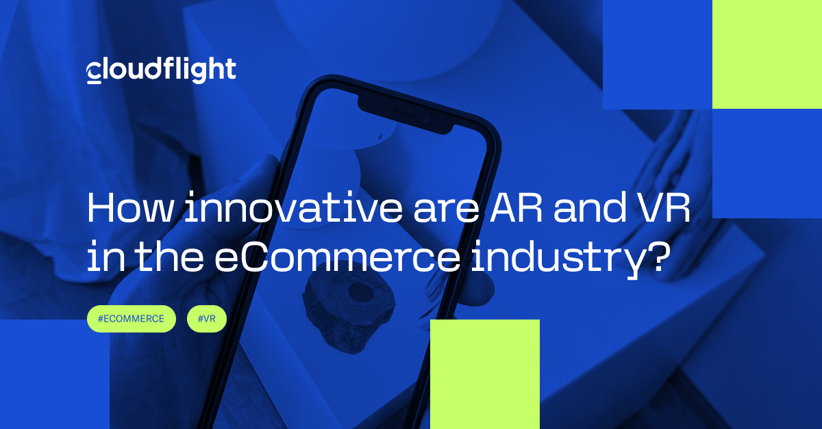Imagine being able to go shopping at your favorite stores from the comfort of your living room. What we mean here is a truly advanced, immersive, and interactive shopping experience that is entirely tailored to you and your interests. Now, imagine if your eCommerce store was able to provide this type of experience to its customers through augmented reality (AR) and virtual reality (VR) technologies.
The development of AR and VR technologies reflects our increasing reliance on digital experiences. Do you want to know more about how AR and VR are going to revolutionize the eCommerce industry? Then read on.
What are AR and VR, and how do they relate to eCommerce?
AR allows users to interact in a virtual world to enhance their real-life surroundings. Using software, apps, and sometimes even headsets, AR overlays digital content onto the real world.
AR allows users to shop for online products interactively. Shoppers can use their phones to try on clothing, place potential furniture options in their homes, and even talk to virtual assistants.
In comparison, VR is a 3D environment that enables users to interact with virtual surroundings similar to reality. Unlike AR, VR users need to wear physical hardware like a headset to enjoy the experience.
Both technologies create an immersive environment. This applies to eCommerce in the form of virtual stores that allow shoppers to look at products closely without leaving the house. Live events in VR and AR worlds may also be part of the eCommerce industry's future.
How are AR and VR technologies currently used in eCommerce?
Free to use image sourced from Unsplash
Right now, eCommerce mainly centers around buying goods online. All you need to do is search for a product on Google, like, for example, "blue blouse," and you'll be met with millions of potential products to choose from. But there are problems with this shopping model.
How do you know if that specific blue blouse will fit? What if you don't like the cut? Does the color match your skin tone? Does it match the rest of your outfit? While before you had to physically return unwanted products to the sender, now you can get a better picture of what you're buying with AR and VR. Correspondingly, the volume of unwanted products will go down.
With VR, you can overlay products on your 3D model to get a better picture of how it will look. No more changing rooms: VR allows you to try on potential outfits from your home. But this technology doesn't just apply to clothing retail.
If you've ever been furniture shopping, you'll be familiar with the frustrations of choosing the right option for your home. You need to measure the furniture, check the dimensions of your room, and then consider whether it fits aesthetically. This process can be time-consuming and take the fun out of shopping for furniture.
AR is already being adopted by furniture companies, such as Swedish giant Ikea. Ikea Place is an AR app that helps customers place and view IKEA products in their room of choice. For example, if you're looking for a new bed, you can try multiple different options and furniture placements before buying the one that suits you best.
What are the benefits of AR and VR in eCommerce?
Free to use image sourced from Unsplash
AR and VR are not only beneficial for eCommerce businesses but also for consumers. Here’s how this burgeoning technology will benefit the future of the eCommerce industry.
Better engagement with customers
No more last-minute abandoned carts. No more frustrated customers dealing with dropped call issues whenever they try to reach your refunds team. With AR and VR, you can take your customer engagement and satisfaction to new heights.
Since VR and AR provide immersive and interactive experiences for consumers, businesses will find it easier to captivate their audiences. Shoppers can get a detailed look at products without leaving their homes and try them out virtually before buying.
By giving customers full service online, businesses will put less pressure on their customer service team. Fewer unhappy customers mean fewer queries. If you have a call center, adding VR and AR shopping experiences for customers may allow you to move to virtual customer service. Read this article on call center management to get a better idea about if this is a good option for your business and customers.
Fewer returns
One of the most frustrating parts of online shopping is dealing with returns. Issues with customer expectations compared to the actual product on arrival can also be tricky for businesses that lose valuable revenue every time a return is made.
VR and AR allow customers to get a better look at products. This reduces the likelihood of them making a return. Again, this can reduce the stress imposed on customer service teams. For businesses that face regular returns, a remote device management tool can help representatives assist customers remotely.
A personalized shopping experience
By combining AR and VR with customer data, businesses can offer personalized shopping experiences. In their own personal VR world, customers can access unique offers relevant to their shopping history.
Offering a personal touch but letting customers have a hands-off shopping experience in the VR world is a great way to increase the likelihood of a purchase. By adding a customer self-service option, users can get on with their shopping needs without contacting a team member.
Potential downsides of AR and VR in an eCommerce setting
Free to use image sourced from Unsplash
With VR and AR being new technologies, some testing is still needed to ensure eCommerce customers have a seamless experience. Here are some initial downsides of the adoption of AR and VR in eCommerce.
Issues and bugs
VR and AR rely on a stable infrastructure and compatibility with different devices. This makes it difficult to adapt for eCommerce businesses that are not up-to-date with the latest immersive technologies.
If you’re a consumer, keeping your devices updated is essential. If you’re still struggling to run AR apps, investing in a new phone or laptop might be worth it.
Less social interaction
Shopping is a social activity for many, and AR/VR experiences might not fully fulfill the social needs of shoppers looking to enjoy the experience with friends or family. This may cause a less enjoyable experience for users who are fond of the social aspect of shopping.
Privacy and security concerns
AR and VR typically require access to user cameras and sensors to create a fully virtual experience. For some, this raises privacy concerns because the image of a user or their home could fall into the wrong hands. Finding the balance between providing consumers with immersive experiences and keeping users' information private is vital to maintaining trust between the customer and the business.
Revolutionize your shopping experiences with AR and VR
Free to use image sourced from Unsplash
Whether you're an avid shopper or an eCommerce business, AR and VR technology will undoubtedly shape how you engage with products and services online. From trying on clothes virtually to redesigning your home with an AR app, you’ll no longer need to shop in-store.
AR and VR aren't just about visuals. They're about tailoring your shopping journey to your unique preferences. Because AR and VR really “get” you, they can make your shopping experience uniquely yours and much more enjoyable and efficient.
|
|
Scott Rigdon, Senior Marketing Copywriter |
Published January 12, 2024












